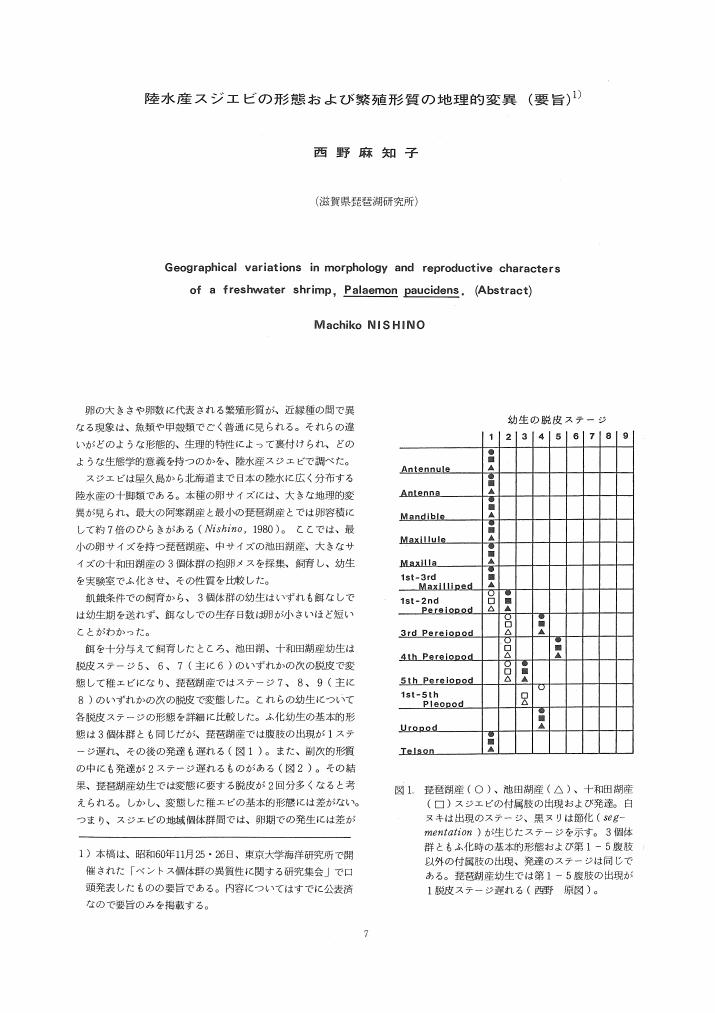1 0 0 0 OA ヤドカリの個体群生態学(総説)
- 著者
- 朝倉 彰
- 出版者
- 日本ベントス学会
- 雑誌
- 日本ベントス研究会誌 (ISSN:18838898)
- 巻号頁・発行日
- vol.1984, no.27, pp.1-13, 1984-10-31 (Released:2009-08-07)
- 参考文献数
- 74
- 被引用文献数
- 2 2
Hermit crabs are anomuran decapod crustaceans which have evolved the behabiour of utilizing empty gastropod shells as portable shelters. This paper briefly reviewed various aspects of population ecology of the hermit crabs. Hermit crabs in the field are generally unable to procure empty shells from living snails. Rather they are dependent ultimately upon snail mortality for shells. Snail size affects some parameters of the population through the individual-level processes of the crabs. Some studies indicate that crab growth is slowed by occupation of too small or too large shells. Fecundity is also affected directly by shell occupancy. Reduced clutch size is correlated with reduced shell size, even after the effects of crab size are taken in account. The flexibility in life history traits which shells regulated trade-off between growth and reproduction was reported. Crabs with large shells put effort to growth, while crabs in shells too small to permit growth allocate more time and energy into reproduction. There are considerable inferential and some direct evidences that hermit crab population are limited by supplies of empty shells. Adding many empty shells to the crab population in the field resulted in increasing the crab density. Finally, some problems of life history tactics of hermit crabs and other marine invertebrates are discussed.
1 0 0 0 OA 淡水ヨコエビ(Jesogammarus sp.)の飼育条件下における成長と繁殖について
- 著者
- 浜島 渡 森野 浩
- 出版者
- 日本ベントス学会
- 雑誌
- 日本ベントス研究会誌 (ISSN:18838898)
- 巻号頁・発行日
- vol.1984, no.26, pp.43-44, 1984-03-31 (Released:2009-08-07)
Growth, survivorship of immature animals and breeding activity in Jesogarrmarus sp, were studied at 9°C, 14°C and 19°C in the laboratory. Growth rates increased with temperatures in isolated condition but decreased in group animals. Initial mortality was highest in 19°C and survivorship was low in group animals than in isolated animals. Breeding was least successful in 19°C in terms of the release of young per female breeding cycle as well as the number of young released per brood. It was concluded that the upper critical temperature for the population of Jesogammarus sp, lay at about 19°C.
1 0 0 0 OA カンザシゴカイ類の生態学的研究
- 著者
- 三浦 知之 梶原 武
- 出版者
- 日本ベントス学会
- 雑誌
- 日本ベントス研究会誌 (ISSN:18838898)
- 巻号頁・発行日
- vol.1983, no.25, pp.40-45, 1983-10-31 (Released:2009-08-07)
- 参考文献数
- 5
- 被引用文献数
- 4 3
1 0 0 0 OA ブンブクウニ類の殻の外形と潜行様式
- 著者
- 金沢 謙一
- 出版者
- 日本ベントス学会
- 雑誌
- 日本ベントス研究会誌 (ISSN:18838898)
- 巻号頁・発行日
- vol.1989, no.35-36, pp.69-74, 1989-08-31 (Released:2009-08-07)
- 参考文献数
- 7
- 被引用文献数
- 1
Sixteen spatangoid species examined are grouped into three types on the basis of their test shape and habitat. The first type having flat shape burrows shallowly in sand, the second type having globular shape burrows deeply in sand, and the third type having wedge shape burrows in mud. The test shape bears a basic relation to resistance of sediment through which they move. Different burrowing mechanisms seen among them are derived from the difference in test shape and resultant function of spines. Test shape of each type and the specific burrowing mechanism fit with respective habitat conditions.
1 0 0 0 OA スジエビの淡水適応(予報)
- 著者
- 益子 計夫
- 出版者
- 日本ベントス学会
- 雑誌
- 日本ベントス研究会誌 (ISSN:18838898)
- 巻号頁・発行日
- vol.1990, no.38, pp.1-6, 1990-03-31 (Released:2009-08-07)
- 参考文献数
- 13
- 被引用文献数
- 2
In the prawn Palaemon (Palaemon) paucidens DE HAAN which is widely distributed in inland fresh waters in Japan, affinity with environmental fresh and saline water was investigated for zoeal larvae. The larval survivorship was much better in diluted sea water (20∼60 % or 80 % concentrations of ordinary artificial sea water) than in fresh water under both conditions of starvation and feeding. Oxygen-consumption rate of newly hatched larvae (first-stage zoeae) was considerably greater in fresh water than in diluted or not diluted sea water, which is regarded to reflect the increment of energy cost for osmoregulation in freshwater medium. The cause of declined survivorship of P. paucidens larvae in fresh water was discussed in connection with their energy consumption and other physiological factors. Judging from larval physiological affinity with saline water, it is very likely that the infered evolutionary change of habitats from saline to fresh waters in this species has been accomplished without acquiring complete adaptation to external freshwater medium.
1 0 0 0 OA 陸水産スジエビの形態および繁殖形質の地理的変異 (要旨)
- 著者
- 西野 麻知子
- 出版者
- 日本ベントス学会
- 雑誌
- 日本ベントス研究会誌 (ISSN:18838898)
- 巻号頁・発行日
- vol.1986, no.30, pp.7-9, 1986-10-31 (Released:2009-09-03)
- 参考文献数
- 2
- 被引用文献数
- 1

